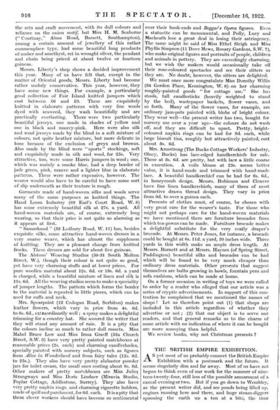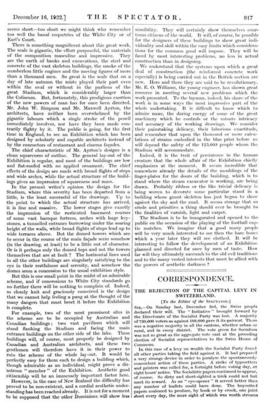THE BRITISH EMPIRE EXHIBITION. yet most of us probably connect
the British Empire 11. Exhibition with a postmark and the future. It seems singularly dim and far away. Most of us have not begun to think even of our work for the summer of nine- teen-twenty-four, still less of the possible amusement of a casual evening or two. But if you go down to Wembley, as the present writer did, and see ponds being filled up, engines running here and there, and huge steam-diggers spooning the earth up a ton at a bit; the time seems short—too short we might think who remember too well the banal coquetries of the White City or of Earl's Court.
There is something magnificent about this great work. The scale is gigantic, the effort purposeful, the materials of the composition masculine and impressive. They arc the earth of banks and excavations, the steel and concrete of the vast skeleton buildings, the smoke of the numberless little engines and the moving figures of more than a thousand men. So great is the scale that on a day of late autumn the mists played their part even within the oval or without in the purlieus of the great Stadium, which is considerably larger than the Coliseum. But, fortunately, this prodigious exertion of the new powers of man has for once been directed. Mr. John W. Simpson and Mr. Maxwell Ayrton, the architects, have neither been overwhelmed by the gigantic labours which a single stroke of the pencil immediately involves, nor have they been made con- trarily flighty by it. The public is going, for the first time in England, to see an Exhibition which has been designed by scholarly and capable architects instead of by the concoctors of restaurant and cinema façades.
The chief characteristic of Mr. Ayrton's designs is a clean squareness of outline. The general lay-out of the Exhibition is regular, and most of the buildings are low and flat-roofed with no applied ornament. The chief effects of the design are made with broad flights of steps and wide arches, while the actual structure of the build- ings gives an impression of squareness and mass.
In the present writer's opinion the design for the Stadium, where this severity has been departed from a little, is the least successful of the drawings. Up to the point to which the actual structure has arrived, it is fine and massive. The lower stages give exactly the impression of the rusticated basement courses of some vast baroque fortress, arches with huge key- stones, a tunnelled entrance burrowing under the soaring height of the walls, while broad flights of steps lead up to wide terraces above. But the domed towers which are to occur in the course of the main façade seem somehow (in the drawing, at least) to be a little out of character. Or is it perhaps only the domed tops and not the towers themselves that are at fault ? The horizontal lines used in all the other buildings are singularly satisfying to the eye in their restfulness and serenity; and somehow the domes seem a concession to the usual exhibition style.
But this is one small point in the midst of an admirable scheme, and if concessions to White City standards go no further there will be nothing to complain of. Indeed, so closely knit and graciously conceived is the design that we cannot help feeling a pang at the thought of the many dangers that must beset it before the Exhibition is complete.
For example, two of the most prominent sites in the scheme arc to be occupied by Australian and Canadian buildings ; two vast pavilions which will stand flanking the Stadium and facing the main entrance buildings on the other side of the lake. These buildings will, of course, most properly be designed by Canadian and Australian architects, and these two gentlemen will therefore have it in their power to ruin the scheme of the whole lay-out. It would be perfectly easy for them each to design a building which, though admirable as an individual, might prove a dis- astrous " member " of the Exhibition. Aesthetic good citizenship will be an immensely important factor here. However, in the case of New Zealand the difficulty has proved to be non-existent, and a cordial aesthetic under- standing has been reached already. It is not for a moment to be supposed that the: otherDominions_ Will show less sensibility. They will certainly show themselves cour- teous citizens of the world. It will, of course, be possible for the designers of these buildings to show great indi- viduality and skill within the easy limits which considera- tions for the common good will impose. They will be faced by most interesting problems, no less in actual construction than in designing.
We understand that the systems upon which a great deal of construction (the reinforced concrete work especially) is being carried out in the British section are new. Here and there they are said to be revolutionary. Mr. E. 0. Williams, the young engineer, has shown great resource in meeting several new problems which the work presented. To the layman, indeed, his share of the work is in some ways the most impressive part of the whole undertaking. It is difficult to know which to admire more, the daring energy of some of the great machinery which he controls or the minute intricacy and accuracy of the working drawings. We consider their painstaking delicacy, their laborious exactitude, and remember that upon the thousand or more calcu- lations of strains embodied in the blue print before us will depend the safety of the 125,000 people whom the Stadium will accommodate.
Indeed, it is the trait of persistence in the human creature that the whole affair of the Exhibition chiefly emphasizes at the moment. It seems incredible that somewhere already the details of the mouldings of the finger-plates for the doors of the building, which is to stand where the steam excavator is working, arc being drawn. Probably ribbon or the like trivial delicacy is being woven to decorate some particular stand in a building whose gaunt skeleton has just begun to show against the sky and the mud. It seems strange that so crude and primitive a thing should ever be brought to the finalities of varnish, light and carpet.
The Stadium is to be inaugurated and opened to the public on the occasion of the playing of the football cup- tie matches. We imagine that a good many people will be very much interested to see then the bare bones which a year later they will see clothed. It will be interesting to follow the development of an Exhibition planned and directed for once by men of taste. How far will they ultimately succumb to the old evil traditions and to the many vested interests that must be allied with the powers of aesthetic darkness ?















































 Previous page
Previous page